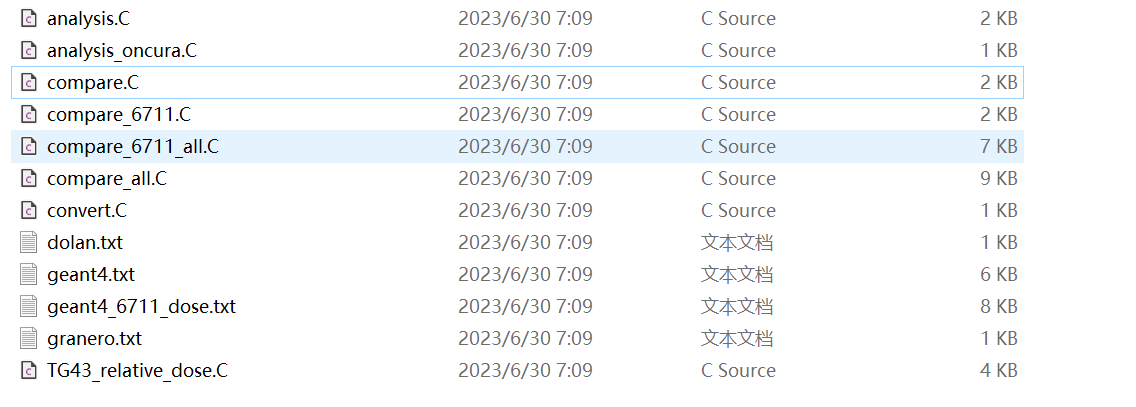Thank you for your words, I know how to run in interactive session, but it doesn’t work in the geant4 tutorial. I post some of the C++ codes as following.
analysis.C
{
// For Flexi source
// eventually convert from ASCII output files to ROOT files
/*
gROOT->ProcessLine(".L convert.C");
ReadASCII("EnergyDeposition_Flexi_livermore.out", "brachytherapy_Flexi_livermore.root");
ReadASCII("EnergyDeposition_Flexi_penelope.out", "brachytherapy_Flexi_penelope.root");
ReadASCII("EnergyDeposition_Flexi_opt0.out", "brachytherapy_Flexi_opt0.root");
ReadASCII("EnergyDeposition_Flexi_opt3.out", "brachytherapy_Flexi_opt3.root");
ReadASCII("EnergyDeposition_Flexi_opt4.out", "brachytherapy_Flexi_opt4.root");
*/
// g(r) is calculated from the root files
gROOT->ProcessLine(".L TG43_relative_dose.C");
Read("Flexi", "livermore");
Read("Flexi", "penelope");
Read("Flexi", "opt0");
Read("Flexi", "opt3");
Read("Flexi", "opt4");
//gROOT->ProcessLine(".x compare.C");
// or...
// plot all results with the alternative EM physics constructors
gROOT->ProcessLine(".x compare_all.C");
// use compare.C when only one physics approach is used
// For Oncura source
/*gROOT->ProcessLine(".L TG43_relative_dose.C");
Read("Oncura", "livermore");
Read("Oncura", "penelope");
Read("Oncura", "opt0");
Read("Oncura", "opt3");
Read("Oncura", "opt4");
gROOT->ProcessLine(".x compare_6711.C");
//or ...
// gROOT->ProcessLine(".x compare_6711_all.C");
*/
}
compare.C
{
// Read reference data in granero.txt
FILE *fg1=fopen("granero.txt", "r");
Int_t n_points_granero =13;
Float_t x1[n_points_granero], y1[n_points_granero];
Float_t x, y;
Int_t ncols_granero;
Int_t nlines1 =0;
while(1)
{
ncols_granero = fscanf(fg1,"%f %f",&x, &y);
if (ncols_granero<0) break;
// std::cout << "x " << x << std::endl;
x1[nlines1]=x;
y1[nlines1]=y;
nlines1++;
}
fclose(fg1);
// Read the results of the brachytherapy advanced example
// FlexiSorceMacro.mac with 280 M events
FILE *fg2=fopen("geant4.txt", "r");
Int_t n_points_geant4 =398;
Float_t x2[n_points_geant4], y2[n_points_geant4];
Int_t ncols_geant4;
Int_t nlines2 =0;
while(1)
{
ncols_geant4 = fscanf(fg2,"%f %f",&x, &y);
if (ncols_geant4<0) break;
// std::cout << "x " << x << std::endl;
x2[nlines2]=x;
y2[nlines2]=y;
nlines2++;
}
fclose(fg2);
TGraph *gr1 = new TGraph (nlines1, x1, y1);
TGraph *gr2 = new TGraph (nlines2, x2, y2);
TCanvas *c1 = new TCanvas("c1","Graph Draw Options",
200,10,600,400);
gPad->SetLogy();
// draw the graph with axis, continuous line, and put
// a * at each point
gr1->SetTitle("Dose rate distribution");
gr1-> GetXaxis()->SetTitle("Distance from the centre (cm)");
gr1->GetYaxis()->SetTitle("Normalised dose rate distribution");
gr1->SetLineWidth(1);
gr1->SetMarkerColor(1);
gr1->SetMarkerStyle(20);
gr1->Draw("AP");
gr2->SetLineWidth(1);
gr2->SetMarkerColor(2);
gr2->SetMarkerStyle(21);
gr2->SetMarkerSize(0.5);
gr2->SetLineColor(2);
gr2->Draw("CP");
TLegend *leg = new TLegend(0.3, 0.5, 0.6, 0.8);
leg->SetFillColor(0);
leg->AddEntry(gr1, "Reference data", "lp");
leg->AddEntry(gr2, "Geant4 - 280 M events", "lp");
leg->Draw();
}
convert.C
void ReadASCII(TString source_file_ascii, TString output_file_root)
{
// This macro converts the results of the simulation stored in ASCII files to ROOT files.
ifstream in;
in.open(source_file_ascii);
Float_t x,y,z, edep;
Int_t nlines = 0;
TFile *f = new TFile(output_file_root,"RECREATE");
TH2F *h20 = new TH2F("h20","h20",801,-100.125,100.125, 801, -100.125, 100.125);
while (1) {
in >> x >> y >> z >> edep;
if (!in.good()) break;
// if (edep !=0.) printf("x=%8f, y=%8f, edep=%8f\n",x,y,edep);
h20->Fill(x,y,edep);
nlines++;
}
printf(" found %d points\n",nlines);
in.close();
f->Write();
}
TG43_relative_dose.C
void Read(TString source, TString physics_list){
// Create output file geant4_dose.txt with the dose rate distribution, calculated
// with the simulation results containted in brachytherapy.root
gROOT -> Reset();
TString fileName="brachytherapy_"+source+"_"+physics_list+".root";
std::cout<< "Reading " << fileName << std::endl;
//const char * c = fileName.c_str();
TFile f(fileName);
Double_t Seed_length = 0.35; //seed length in cm
Double_t EnergyMap[401]; //2D map of total energy in "radial distance (mm)" and "angle (5 degrees)"
Int_t Voxels[401]; //the number of voxels used to provide dose to each element of the energy map
Double_t normDose[401]; //Energy map divided by voxels used to make cell, normalised to energy deposition at 1cm, 90 degrees
Double_t GeomFunction[401]; //Geometry Function, normalised to the geometry function at the reference point
Double_t GeometryFunctionZero; //Geometry function at reference point, 1cm and 90 degrees
Double_t beta; //beta angle for Geometry Function calculation
Double_t R; //radial distance in cm
Double_t K; //polar angle in radians
Double_t Radial[401]; //radial dose function
Double_t radius; //radius (mm)
Int_t radInt; //nearest integer of radius (mm)
Int_t numberOfBins=801;
for (int i=0; i <401; i++)
{
EnergyMap[i]=0.;
Voxels[i]=0.;
}
//Build Energy Deposition Map
for (int k=0; k< numberOfBins; k++)
{
for (int m=0; m< numberOfBins; m++)
{
Double_t xx_histo = h20->GetXaxis()->GetBinCenter(k);
Double_t yy_histo = h20->GetYaxis()->GetBinCenter(m);
Double_t edep_histo=h20->GetBinContent(k, m);
radius = sqrt(xx_histo*xx_histo+yy_histo*yy_histo);
// if ((edep_histo!=0) && radius < 12. && radius > 9) std::cout << "histo: " << xx_histo << ", " << yy_histo
// << ", radius: " << radius <<", edep: "<< edep_histo << std::endl;
if (radius != 0){
radInt = TMath::Nint(4*radius);
if ((radInt>0)&&(radInt<=400))
{
EnergyMap[radInt]+= edep_histo;
Voxels[radInt]+= 1;
// if (radius < 12. && radius > 9 && edep_histo!=0)std::cout<< "Radius: " << radius << ", radInt:"<<radInt << ", EnergyMap: "<< EnergyMap[radInt]<< ", voxels: " << Voxels[radInt]<< std::endl;
}
}
}}
//Create Normalised Dose Map
std::cout << "The energy deposition at the reference point is " << EnergyMap[40] << std::endl;
Double_t tempNormValue = EnergyMap[40]/Voxels[40];
//value at 1cm, 90 degrees, the normalisation point
std::cout << "Dose rate ditribution (distances in cm)" << std::endl;
ofstream myfile;
TString outputFileName ="geant4_dose_"+ source+"_"+physics_list+".txt";
//const char * cOutputFileName = fileName.c_str();
myfile.open(outputFileName);
std::cout << "file " << outputFileName << " is created "<<std::endl;
for (int i=0; i<=400; i++)
{
R = double(i)/40; //distance in CM!!!
if (Voxels[i]>0) normDose[i] = EnergyMap[i]/Voxels[i]/tempNormValue;
else normDose[i] = 0;
if (R> 0.05)
{
// cout << R << " " << normDose[i] << endl;
myfile << R << " " << normDose[i] << "\n";
}
}
myfile.close();
}
Last file have a function that need arguments, I wonder if I should put the arguments in command line. And where is the entrance of the program?
